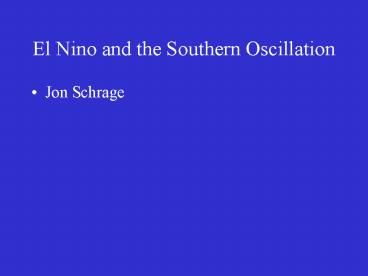El Nino and the Southern Oscillation - PowerPoint PPT Presentation
1 / 33
Title:
El Nino and the Southern Oscillation
Description:
El Nino and the Southern Oscillation Jon Schrage Two Aspects of ENSO Atmospheric Aspect : Southern Oscillation Ocean Aspect : El Nino and La Nina However ... – PowerPoint PPT presentation
Number of Views:239
Avg rating:3.0/5.0
Title: El Nino and the Southern Oscillation
1
El Nino and the Southern Oscillation
- Jon Schrage
2
Two Aspects of ENSO
- Atmospheric Aspect Southern Oscillation
- Ocean Aspect El Nino and La Nina
- However, this distinction is not universal and
not realthe atmosphere and ocean are an
interacting system!
3
Southern Oscillation
This is the normal situation in the atmosphere.
4
This is the normal situation in the atmosphere.
5
It is (part of) what drives the observed ocean
currents in the equatorial Pacific.
6
This is the normal situation in the atmosphere
and the ocean.
7
(No Transcript)
8
Notice that it depends on there being high
pressure in the southeastern Pacific and
(relatively) low pressure over Indonesia!
9
Normal Situation
El Nino Situation
El Nino/Southern Oscillation
10
El Nino
- Happens (on average) every 2-7 years.
- Average 4 years apart
- El Nino conditions last for about a year.
- KEY IMPACT Warm water anomalies in the Western
Pacific move to the eastern Pacific!
11
(No Transcript)
12
History of the term El Nino
- A reference to the Christ child
- There is a warming event along the coast of Peru
every December, named El Nino in deference to
the nativity.
13
History of the term El Nino
- Climate researchers have come to refer to the
much stronger warming that occurs every 4-5 years
as El Nino. - The opposite of this condition is La Nina, or
anti-El Nino. (Unusually cold water off the
coast of South America.)
14
Why did the warm water move from the western PAC
to the eastern PAC?
- Either
- The pile of water in the western PAC got so big
that the trade winds were not capable of holding
it back any more, - Or
- The trade winds weakened, and the pile of water
sloshed eastward.
15
Either way
- The trade winds along the equator were important.
- And their strength depends on the east-west
pressure difference!
Low
High
16
Southern Oscillation Index (SOI)
- Reflects the magnitude and phase of the
ATMOSPHERIC component of ENSO - SOI (Normalized sea level pressure anomaly at
Tahiti) (Normalized sea level pressure at
Darwin) - SOI Tahiti - Darwin
17
Low
High
- During La Nina conditions
- Pressure at Tahiti is high, pressure at Darwin is
low, so SOI gt 0.
- During El Nino conditions
- Pressure at Tahiti is low, pressure at Darwin is
high, so SOI lt 0.
High
Low
18
(No Transcript)
19
During El Nino, when the SOIlt0, the trade winds
can no longer support the higher SSHs in the
Western Pacific, and the water moves eastward.
20
The SSH anomaly moves as a Kelvin Wave!
- Here is a SSH anomaly along the equator.
High
0N
21
The SSH anomaly moves as a Kelvin Wave!
- There is a PGF acting to disperse the anomaly.
High
0N
22
The SSH anomaly moves as a Kelvin Wave!
- The ocean in geostrophic balance CF balances PGF.
PGF
PGF
PGF
High
0N
23
The SSH anomaly moves as a Kelvin Wave!
- Resulting in the following flow
PGF
PGF
PGF
High
0N
PGF
PGF
PGF
24
The SSH anomaly moves as a Kelvin Wave!
- Water is moved away from the west side--SSH falls.
PGF
PGF
PGF
High
0N
PGF
PGF
PGF
25
The SSH anomaly moves as a Kelvin Wave!
- Water is moved towards the east side--SSH rises.
PGF
PGF
PGF
High
0N
PGF
PGF
PGF
26
The SSH anomaly moves as a Kelvin Wave!
- Water is moved towards the east side--SSH rises.
0N
27
The SSH anomaly moves as a Kelvin Wave!
- This works just as well for a negative SSH
anomaly!
CF
CF
CF
Low
0N
PGF
PGF
PGF
CF
CF
CF
28
The SSH anomaly moves as a Kelvin Wave!
- This works just as well for a negative SSH
anomaly!
0N
29
Kelvin Waves
- All move eastward
- All are equatorially trapped
- Can happen in the atmosphere or in the ocean.
- Can happen at the surface of the ocean, or on the
thermocline.
30
(No Transcript)
31
Effects of El Nino
32
So does the Southern Oscillation cause El Nino,
or does El Nino cause the Southern Oscillation?
- The question is meaningless. They happen
together as a single manifestation of the
internal variability of the ocean-atmosphere
system. - It is true that sometimes the ocean either leads
or lags the atmosphere, however.
33
- This would be a good time to watch the little
video about the El Nino of 1997-98.































